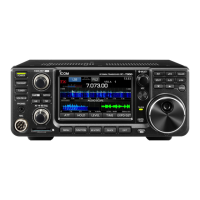12
SET MODE
12-9
Connectors (Continued)
CI-V USB Baud Rate (Default: Auto)
Selects the CI-V data transfer rate when remotely
controlling the IC-7300 through the
[USB]
CI-V port
.
• Options: 4800, 9600, 19200, 38400, 57600, 115200
(bps), or Auto
L When “Auto” is selected, the baud rate is
automatically set according to the data rate of
external controller.
L This setting is valid only when the “CI-V USB Port”
item is set to “Unlink from [REMOTE].”
CI-V USB Echo Back (Default: OFF)
Turns the Data Echo Back function ON or OFF, when
remotely controlling the IC-7300 through the [USB]
CI-V port.
• OFF: Turns OFF the function.
• ON: Turns ON the function.
L This setting is valid only when the “CI-V USB Port”
item is set to “Unlink from [REMOTE].”
USB Serial Function (Default: CI-V)
Selects the signal output from [USB].
• CI-V: A CI-V command is output.
• RTTY Decode: An RTTY decoded signal is output.
RTTY Decode Baud Rate (Default: 9600)
Selects the data transfer rate (Baud rate) of decoded
RTTY signals.
• Options: 4800, 9600, 19200, or 38400 (bps)
TIP: About the “USB SEND,” “USB Keying (CW),” and
“USB Keying (RTTY)” items
L When you operate RTTY or CW through your PC’s USB
port and your IC-7300, you may not be able to send
“SEND” or “Keying” signals until a few seconds after
you connect the USB cable.
L When you operate RTTY or CW through your PC’s USB
port and the IC-7300, and connect a second transceiver
to another PC USB port, a short “SEND” or “Keying”
signal will be sent from the rst transceiver. Therefore,
we recommend that you do not connect a second
transceiver to a USB port of the same PC. Or, always
turn OFF the transceiver power before you connect a
USB cable.
USB SEND (Default: OFF)
You can control transmit and receive from the PC
through the USB port.
Selects the control port to be used for communication
between the IC-7300 and PC, according to the
operating condition.
• OFF: Turns OFF the function.
• DTR: Uses the DTR terminal on the CI-V (PC) side.
• RTS: Uses the RTS terminal on the CI-V (PC) side.
L You cannot select the terminal which is already
selected in the “USB Keying (CW)” or “USB Keying
(RTTY)” item.
USB Keying (CW) (Default: OFF)
You can control transmit, receive and keying from the
PC, through the USB port.
Selects the control port to be used for communication
between the IC-7300 and PC, according to the
operating condition.
• OFF: Turns OFF the function.
• DTR: Uses the DTR terminal on the CI-V (PC) side.
• RTS: Uses the RTS terminal on the CI-V (PC) side.
L You cannot select the terminal which is already
selected in the “USB SEND” or “USB Keying
(RTTY)” item.
USB Keying (RTTY) (Default: OFF)
You can control transmit, receive and RTTY (FSK)
from the PC, through the USB port.
Selects the control port to be used for communication
between the IC-7300 and PC according to the
operating condition.
• OFF: Turns OFF the function.
• DTR: Uses the DTR terminal on the CI-V side.
• RTS: Uses the RTS terminal on the CI-V side.
L You cannot select the terminal which is already
selected in the “USB SEND” or “USB Keying (CW)”
item.

